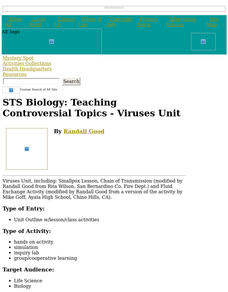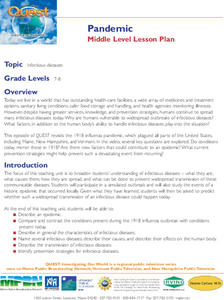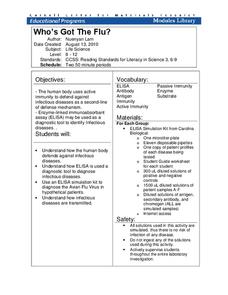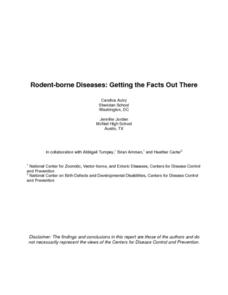Howard Hughes Medical Institute
Genetic Mutations and Disease Interactive
Genetic mutations occur throughout life, from conception to old age, and the timing influences the severity. Young scientists learn about four different mutation times and the diseases that sometimes occur as a result. They observe the...
US National Library of Medicine
Science and Society: Preventing the Spread of Disease
Looking for a valuable resource on the spread of infectious diseases? Here is a instructional activity in which pupils simulate the spread of diseases and learn about how to prevent them from spreading. Class members read case studies...
Howard Hughes Medical Institute
Stopping Mosquito-Borne Disease
Fifty million people catch dengue fever each year. Understanding the transmission and symptoms of this disease helps people prevent and treat it. Learn about multiple intervention strategies and view graphs of their effects to stop the...
Curated OER
Disease & Epidemics: Architects of History
Students explore disease and its relationship to history and literature. They investigate issues that range from early biological warfare and historical disease treatments, to observing today's race for the cure against current emerging...
Curated OER
Myth Busters: HIV Transmission
Learners discuss the facts and myths about HIV. In this health lesson plan, students explain how diseases spread from person to another. They create a presentation to share their research findings with the class.
Curated OER
Infectious Disease Detectives
Students participate in a simulation of how diseases are transmitted. Each student holds a test tube, with only one containing the "disease" while the others have water. They move around the room until told to stop. Using droppers to...
Curated OER
The Nature of Disease
In this diseases worksheet, students will learn about infectious diseases including what causes a diseases and how they are spread. Students will also review symptoms of disease, patterns of diseases, and treating diseases. This...
Howard Hughes Medical Institute
Ebola: Disease Detectives
How did the Ebola virus first infect humans? Young virologists examine genetic sequences from the 2014 Sierra Leone outbreak to find similarities during a riveting activity. Following similar methods used by MIT and Harvard, partners...
Curated OER
Transmission of Disease
Young scholars provide names of viral diseases that they would possibly like to be infected with today; listing them on the Smart Board. They then come to an agreement about what virus to use and use beakers of fluids to simulate how...
Curated OER
Waterborne Diseases
Students compare symptoms of several well-known water-borne diseases. They use the symptoms and background information on the disease to explain some of the aspects in terms of immune response.
Curated OER
Simulating the Spread of an Infectious Disease
In this health worksheet, students identify various infectious diseases and explore the available options for stopping or preventing the spread of disease. They participate in a simulation experiment on how to measure and prevent. There...
Curated OER
Sexually Transmitted Diseases: Overview
Students observe human heath by completing a worksheet in class. In this STD lesson, students identify the different types of diseases which are spread through sexual intercourse and what symptoms will become noticeable. Students...
Curated OER
Tuberculosis Project
Reasearch the transmission of tuberculosis and design a communication product to help youth understand the risks of the disease, how it is tested for, and the benefits of proper treatment. This project incorporates language arts, math,...
Curated OER
West Nile Virus-What is the Risk?
Begin with an online pre-quiz about West Nile Virus. Using a fictional scenario, young epidemiologists read how it is transmitted and examine the stages of the life cycle of a mosquito. They imagine that they are members of the Centers...
Curated OER
The Cantankerous Pathogen
Students explore what factors influence the spread of infectious diseases. They explain how human manipulation of the environment affects the transmission of diseases.
Curated OER
Viruses
A fliud exchange activity using pipettes/droppers to exchange fluids with at least 3 people. your students are advised not to spill any liquid. Droppers are collected in a large beaker, and students return to desks while holding tubes....
Curated OER
Pandemic
Students compare and contrast the conditions of the 1918 influenza outbreak with those of today. They try to identify prevention strategies for infectious diseases.
Curated OER
Straining to Understand Viruses
Students examine the differences among the strains of deadly viruses and create research-based visual displays about the origins of different strains, transmission, symptoms, treatments and historic impact of specific viruses.
Curated OER
Epidemic, Plague, and Infection
Students recognize disease vectors (pathways) and risk factors for infectious diseases.
Cornell University
Who’s Got The Flu?
Become an immunologist for the day. Scholars elicit the use of the enzyme-linked immunoabsorbent assay (ELISA) to diagnose an infectious disease. Through the process, they learn about the immune system response to infectious diseases.
Curated OER
HIV/AIDS & Other STDs, Day 1: Germs & Risk
Assist your secondary special education class for understanding risky behavior, hygiene, and STDs. The class discusses how germs spread, how people get sick, and what needs to be done to prevent the spread of communicable diseases. They...
Curated OER
Rodent-borne Diseases: Getting the Facts Out There
High schoolers conduct research of the hantavirus pulmonary syndrome (HPS) or lymphocytic choriomeningitis (LCMV). They obtain the information and create a public announcement in the form of a brochure, newsletter, poster, radio...
Curated OER
Disease Hits Home
Students are provided with the name of a disease, and using library and internet facilities, are asked to explore and explain the route of transmission of this disease in their specific case study. Familiar diseases are then categorized...
College Board
2005 AP® Environmental Science Free-Response Questions
Can the increase in meat production keep pace with the increase in population? Individuals analyze data to determine when human populations will exceed meat production at the current rates of increase. They also consider infectious...























